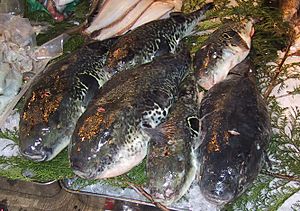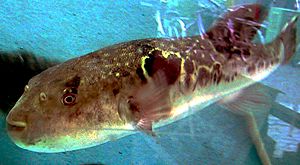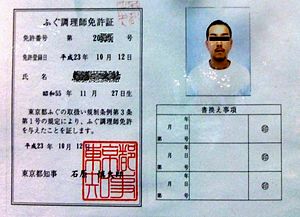Fugu facts for kids
The fugu is a type of pufferfish found in Japanese, Korean, and Chinese cuisine. It's usually from the Takifugu, Lagocephalus, or Sphoeroides groups, or sometimes a porcupinefish from the Diodon group. Fugu can also refer to a special dish made from these fish.
Fugu is known for being very poisonous to humans because of a toxin called tetrodotoxin. This means it must be prepared with extreme care to remove all the toxic parts and make sure the meat isn't contaminated.
In Japan and other countries, preparing fugu in restaurants is strictly controlled by law. Only chefs who have trained for at least three years and passed tough exams are allowed to prepare it. If people try to prepare fugu at home, it can sometimes lead to accidental deaths.
Fugu is often served as thin slices called sashimi or in a hot pot dish called nabemono. The liver, called fugu-kimo, used to be a popular dish because many thought it was tasty. However, it's also the most poisonous part, so serving it in restaurants was banned in Japan in 1984. Fugu has become one of the most famous dishes in Japanese cuisine.
Contents
- Why is Fugu Poisonous?
- The History of Eating Fugu
- Types of Fugu Eaten
- Rules for Fugu Chefs
- How Much Does Fugu Cost?
- What is Tetrodotoxin?
- What Happens if Someone is Poisoned?
- Fugu Poisoning Incidents
- How Fugu is Prepared
- Where Can You Find Fugu?
- Fun Facts About Fugu
- Farming Non-Toxic Fugu
- Images for kids
- See also
Why is Fugu Poisonous?
Fugu contains deadly amounts of a poison called tetrodotoxin in its organs, especially the liver, ovaries, eyes, and skin. This poison is a sodium channel blocker. It paralyzes the muscles while the person stays fully awake. This means the poisoned person cannot breathe and eventually dies from asphyxiation (lack of oxygen). There is no known cure for fugu poison. Doctors try to help by supporting the person's breathing and circulatory system until their body can get rid of the poison.
Scientists have found that fugu get their tetrodotoxin from eating other animals that carry bacteria with this toxin. The fish themselves become used to the poison over time. Because of this, researchers and fish farmers have worked to produce safe fugu. Farmers can now raise poison-free fugu by keeping the fish away from these bacteria. For example, Usuki, a town in Ōita Prefecture, is known for selling fugu that isn't poisonous.
The History of Eating Fugu


People in Japan have been eating fugu for hundreds of years. Fugu bones have been found in ancient garbage piles, called kaizuka, from the Jōmon period, dating back over 2,300 years.
During the Tokugawa shogunate (1603–1868), eating fugu was banned in Edo (now Tokyo) and nearby areas. But as the power of the Shōgun weakened, it became popular again. In western Japan, where the government had less control, people developed different ways to eat fugu safely. During the Meiji Era (1867–1912), fugu was banned again in many places. It's said that the Emperor of Japan has never eaten fugu due to a very old ban.
In China, people were already eating pufferfish during the Song dynasty. It was considered one of the 'three delicacies of the Yangtze River'. Famous writer Su Shi even said that the taste was "worthy of death"!
Types of Fugu Eaten
The torafugu, or tiger pufferfish (Takifugu rubripes), is the most prized type of fugu to eat, and it's also the most poisonous. Other types are eaten too, like Higanfugu (T. pardalis) and Mafugu (T. porphyreus).
The Ministry of Health, Labour and Welfare of Japan provides a list showing which parts of each fugu species can be safely eaten. This list includes safe types of pufferfish from the Lagocephalus and Sphoeroides groups, and also porcupinefish (Harisenbon).
Rules for Fugu Chefs
There are strict rules for fishing fugu to make sure there are enough fish for the future. Most fugu are caught in the spring during their spawning season. Many are also raised in floating cages in the Pacific Ocean. The biggest market for fugu in Japan is in Shimonoseki.
Fugu prices go up in autumn and are highest in winter because the fish get fatter to survive the cold. Live fugu often arrive at restaurants and are kept in large tanks for everyone to see. You can also find prepared fugu in grocery stores, but these stores must show official licenses. Whole, unprepared fugu fish cannot be sold to the public.
Since 1958, fugu chefs must get a special license to prepare and sell fugu. This means they have to train for two or three years. The licensing exam includes a written test, a test to identify different fish, and a practical test where they prepare and even eat the fish. Only about 35% of people who try the exam pass. Even small mistakes can lead to failure or, in very rare cases, death. Because of this tough training, people feel safer eating fugu in restaurants or buying it from licensed markets. Also, some fugu sold commercially are raised in ways that make them less toxic.
Since October 2012, restaurants in Japan have been allowed to sell fugu that has been prepared and packaged by a licensed chef somewhere else.
How Much Does Fugu Cost?
The torafugu, which is the most common type of fugu, costs between ¥1000 and ¥5000 per kg (about $7 to $35 USD), depending on the season. Because it's so expensive, chefs slice the fish very carefully to get as much meat as possible. They use a special knife called a fugu hiki, which is usually kept separate from other knives.
What is Tetrodotoxin?
Tetrodotoxin (TTX) is a natural poison found in pufferfish, but also in other animals like octopuses, crabs, shellfish, frogs, and newts. It's a very strong neurotoxin that stops electrical signals in nerves. It works by blocking special parts called sodium channels in the cells. This poison does not cross the blood–brain barrier, which means it doesn't affect the brain directly. Pufferfish are not affected by the poison because they have a special change in their sodium channel proteins.
TTX is not made by the pufferfish themselves. Instead, bacteria like Alteromonas, Shewanella, and Vibrio species live inside or with these animals and produce the toxin.
In studies with mice, a very small amount of TTX (232 micrograms per kg of body weight) was enough to be deadly. The amount of tetrodotoxin in fugu can be reduced by careful preparation, like removing toxic parts or using methods like curing and pickling. However, cooking does not significantly reduce the poison.
What Happens if Someone is Poisoned?
Symptoms of tetrodotoxin poisoning include feeling dizzy, tired, having a headache, feeling sick to your stomach, or having trouble breathing. The person stays awake but cannot speak or move. If the dose is high, breathing stops, leading to asphyxiation.
There is no known antidote (cure). Doctors try to help by emptying the stomach, giving activated charcoal to soak up the toxin, and putting the person on life support until the poison leaves their body. Scientists are still working to develop an antidote for tetrodotoxin.
Fugu Poisoning Incidents
Between 1996 and 2006, there were about 20 to 44 fugu poisoning incidents each year in Japan. Some of these affected multiple people. Each year, between 34 and 64 people were hospitalized, and zero to six people died. The average death rate was about 6.8%. Out of 23 incidents reported in Tokyo from 1993 to 2006, only one happened in a restaurant. All the others involved people catching and eating the fish themselves.
One famous victim was the Kabuki actor Bandō Mitsugorō VIII. In 1975, he died after eating four servings of fugu kimo (fugu liver), which was banned at the time. Bandō thought he could resist the poison, but he died several hours after returning to his hotel.
In August 2007, a doctor in Thailand reported that dishonest fish sellers sold pufferfish meat disguised as salmon. This caused fifteen deaths over three years. About 115 people were taken to hospitals. Fugu had been banned in Thailand five years before these deaths.
In March 2008, a fisherman in the Philippines died, and his family became sick from pufferfish. The year before, four people in the same town died after eating the same type of pufferfish.
In November 2011, a chef at a famous fugu restaurant in Tokyo was suspended. He served fugu liver to a customer who asked for it, even though he was warned of the risks. The customer needed hospital treatment for mild paralysis but fully recovered.
In December 2020, three people in the Philippines died, and four more were hospitalized after eating pufferfish.
How Fugu is Prepared
Japanese Preparations
- Sashimi — The most popular fugu dish is sashimi, also called Fugu sashi or tessa. Chefs use very thin knives to cut fugu into almost see-through slices, a technique called Usuzukuri (薄造, うすづくり).
- Milt — The soft roe (Shirako) of the pufferfish is a highly valued food in Japan. It's often grilled and served with salt.
- Fried — Fugu can be deep-fried as Fugu Kara-age.
- Smoked — Hire-zake is a special sake (rice wine) that has the smoked fin of the fugu added to it. This gives it a unique smoky, fishy flavor.
- Stew — Fugu and vegetables can be simmered together in a stew called Fugu-chiri, also known as tetchiri. The fish's light taste blends with the vegetables and dipping sauce.
- Salad — If the spikes are removed from the fugu's skin, the skin can be eaten in a salad called yubiki.
In Hakusan, Ishikawa, fugu ovaries are prepared by salting and pickling them for three years to reduce the toxin. This special process is only allowed in certain areas of Ishikawa Prefecture and must follow traditional methods. After one year, about 10% of the toxin might still be there. After the full three years, the product is sold only after being checked for safety.
Korean Preparations
In Korean cuisine, edible pufferfish are prepared in different ways:
- gui (grilled)
- jorim (simmered)
- jjim (steamed)
- Bulgogi (marinated and grilled)
- Hoe (raw fish)
- guk (soup)
Where Can You Find Fugu?
Most Japanese cities have fugu restaurants, sometimes grouped together. A famous fugu restaurant is Takefuku in the Ginza area of Tokyo. Zuboraya is another popular chain in Osaka.
In South Korea, fugu is called bok-eo (복어). It's very popular in port cities like Busan and Incheon. It's used in many dishes, like soups and salads, and it costs a lot.
Fugu is cleaned of its most toxic parts in Japan and then flown frozen to the United States. Fugu chefs for American restaurants are trained just as strictly as in Japan. Pufferfish found in American waters have also been eaten, sometimes causing poisonings.
The sale of fugu is completely forbidden in the European Union. In Switzerland, it's legal to import fugu, but only if it's for personal use.
In 1989, a Japanese restaurant owner named Nobuyoshi Kuraoka fought for five years to get permission to import Japanese Tiger pufferfish to his restaurant in Manhattan. By 2003, only seventeen restaurants in the United States were licensed to serve fugu.
Fun Facts About Fugu
In the Kansai region of Japan, people sometimes call fugu teppō, which means "rifle" or "gun." This is a play on words because the Japanese word ataru can mean both "to be poisoned" and "to be shot." In the Shimonoseki area, the old pronunciation fuku is more common than fugu. Fuku also sounds like the Japanese word for "good fortune," while fugu sounds like "disabled."
Every year, at the peak of fugu season, the fugu association at the Tsukiji fish market holds a ceremony. They release hundreds of caught fugu into the Sumida River. A similar ceremony also happens at another large market in Shimonoseki.
A funny Japanese short story, called rakugo, tells about three men who made a fugu stew but weren't sure if it was safe. To test it, they gave some to a beggar. When he seemed fine, they ate the stew. Later, they met the beggar again and were happy to see he was still healthy. But what they didn't know was that the wise beggar had hidden the stew instead of eating it! Once he saw they were fine, he knew it was safe and ate it himself. The three men had been tricked.
Lanterns can be made from the dried bodies of fugu. You might see these outside fugu restaurants, or as toys, folk art, or souvenirs. Fugu skin is also used to make everyday items like wallets or waterproof boxes.
Farming Non-Toxic Fugu
Scientists at Nagasaki University have successfully raised non-toxic torafugu by controlling what the fish eat. They raised over 5,000 fish between 2001 and 2004 and checked the toxicity of their muscles, skin, livers, and other parts. The team found that the amount of tetrodotoxin in all these parts was not dangerous. This means it might be possible to safely prepare fugu-kimo (puffer liver) from these farmed fish in the future.
Images for kids
-
Fugu-nabe, pufferfish hotpot
-
Bogeo-bulgogi
-
Bogeo-gui (grilled pufferfish)
-
Bogeo-jorim (simmered pufferfish)
-
Bokguk (pufferfish soup)
See also
 In Spanish: Fugu para niños
In Spanish: Fugu para niños












